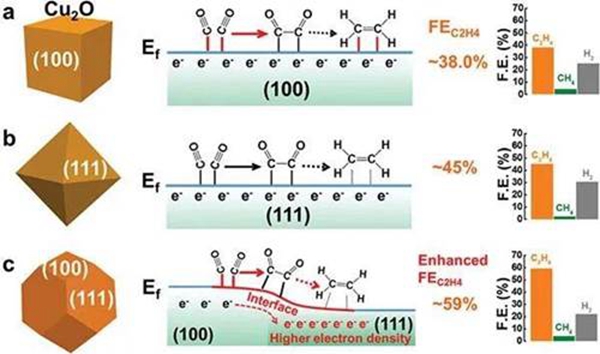
Recently, Professor Huang Baibiao's group, from the State Key Laboratory of Crystal Materials, developed a new strategy that can convert CO2 to C2H4 with high selectivity and activity through crystal facets engineer. This work has been published in Advanced Science 2020, 1902820. The first author of this paper is Gao Yugang, and the corresponding authors are Prof. Huang Baibiao and Prof. Wang Zeyan from the State Key Laboratory of Crystal Materials, Shandong University.
Carbon dioxide (CO2) is known as one of the major "greenhouse gases" that is highly responsible for the global warming and climate change. Thus, it is urgent to reduce the amount of CO2in atmosphere. The electrocatalytic CO2reduction is an attractive strategy because it can transform CO2into high valued feedbacks with high efficiency by utilizing renewable energies. However, it is still a great challenge to transform CO2into C2+products with high selectivity. Based on the isotropic feature of crystal materials, Prof. Huang's group has proposed a new strategy by controlling the exposed crystal facets of Cu2O nanoparticles (NPs) to enhance the selectivity and activity of CO2electroreduction to C2H4. The results indicates that the Cu2O NPs with {111} and {100} facets exposed exhibit higher selectivity and activity than that enclosed with only {111} or {100} facets during CO2electroreduction to C2H4. According to the theoretical calculations, the enhanced selectivity for C2H4production can be attributed to the synergistic effects of Cu2O {111} and {100} facets, which can promote the C-C coupling and facilitate the desorption of C2H4. This work provides a new route for enhancing the selectivity of electrocatalytic CO2reduction by crystal facet engineering.
Prof. Huang's group has committed to the research on energy and environmental materials since 2007, and has made some progress on plamonic photocatalysts, polar photocatalysts, single crystalline photoanodes, etc. The related works have been published on Angew. Chem. Int. Ed., J. Am. Chem. Soc., Adv. Mater. with many works are selected as ESI top 1% highly cited papers.
This work is supported by the State Key Laboratory of Crystal Materials, National Natural Science Foundation of China, Taishan Scholar Program of Shandong Province, and Qilu Young Scholar Program of Shandong University.
The link of this paper: https://onlinelibrary.wiley.co
Source: the State Key Laboratory of Crystal Materials, Shandong University
Written by: Wang Zeyan
Edited by: Xie Tingting